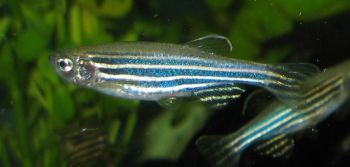Broadcast: News items
Senses of smell and vision interact in the eye, Sussex researchers find
Posted on behalf of: Sussex Neuroscience
Last updated: Tuesday, 16 July 2013

Zebrafish have fluorescent proteins designed to light up when synapses are active.
New research by Sussex neuroscientists suggests that the interaction between smell and sight occurs not just in the brain, but starts in the eye.
The study, carried out by Professor Leon Lagnado’s research group in the School of Life Sciences and published in the journal Neuron, has furthered our understanding of how the senses interact with one another.
The team of researchers, led by postdoctoral researcher Federico Esposti, used a special ‘multiphoton’ microscope to look into the retina of live zebrafish and observe messages sent to the brain in response to different visual stimuli and smells. They found that food-related smells ‘re-tune’ the vision of zebrafish by making the retina more sensitive to moving objects, such as prey.
Professor Lagnado says: “The way the brain processes information from one sense depends on the activity of other senses. For instance, we know that to listen closely to some music, it often helps to shut your eyes. We also know that some odours send signals directly from the nose to the retina. Now we can show that the sense of smell also interacts with the sense of vision.”
The retina splits visual information into two pathways - the “ON” pathway responds to increases in light intensity and the "OFF" pathway to decreases in light intensity. The team found that food smells act on the OFF pathway, making the retina more sensitive to regions of negative contrast, such as dark spots caused by prey moving across the field of vision. The key brain chemical involved in this process is dopamine, which increases the sensitivity of the retina’s response to food smells.
“It seems likely that the interaction between the sense of smell and the sense of vision not only occurs in the central part of the brain, but starts in the retina itself,” says Professor Lagnado. “This process of olfactory-visual integration is likely to be relevant to different aspects of behavior, especially hunting and prey-capture in zebrafish.”
The team is the first in the world to be able to observe the activity of hundreds of synapses (brain signals) in live animals. Zebrafish are used in studies of this nature because they have fluorescent proteins designed to light up when synapses are active.
The research was supported by the Medical Research Council and a grant from the Wellcome Trust.
Professor Lagnado was appointed earlier this year as the first Director of Sussex Neuroscience, a major new initiative to establish the University as a centre of excellence in neuroscience. He has built an international reputation for his research in sensory neuroscience and joined Sussex from the Medical Research Council Laboratory of Molecular Biology at Cambridge.

